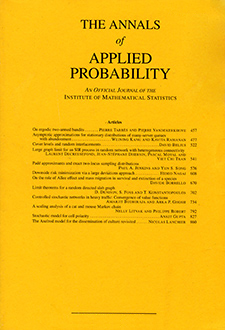Abstract
We obtain rates of convergence to stationarity in $L^{1}$-Wasserstein distance for a $d$-dimensional reflected Brownian motion (RBM) in the nonnegative orthant that are explicit in the dimension and the system parameters. The results are then applied to a class of RBMs considered in (Blanchet and Xinyun (2016)) and to rank-based diffusions including the Atlas model. In both cases, we obtain explicit rates and bounds on relaxation times. In the first case we improve the relaxation time estimates of $O(d^{4}(\log d)^{2})$ obtained in (Blanchet and Xinyun (2016)) to $O((\log d)^{2})$. In the latter case, we give the first results on explicit parameter and dimension dependent rates under the Wasserstein distance. The proofs do not require an explicit form for the stationary measure or reversibility of the process with respect to this measure, and cover settings where these properties are not available. In the special case of the standard Atlas model (In Stochastic Portfolio Theory (2002) 1–24 Springer), we obtain a bound on the relaxation time of $O(d^{6}(\log d)^{2})$.
Citation
Sayan Banerjee. Amarjit Budhiraja. "Parameter and dimension dependence of convergence rates to stationarity for reflecting Brownian motions." Ann. Appl. Probab. 30 (5) 2005 - 2029, October 2020. https://doi.org/10.1214/19-AAP1550
Information





